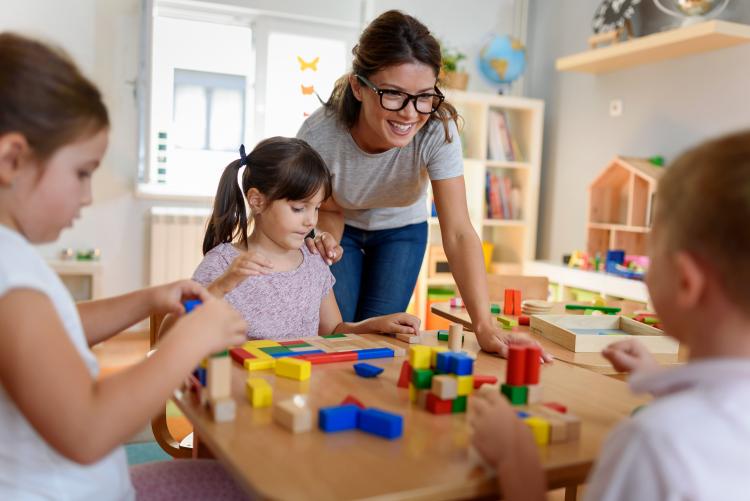With the move to more online working and collaborations, it is becoming more apparent that this style of working has helped the introverts excel. I have been reading articles about how the ‘working from home world’ has helped the introverts shine, which got me thinking about how this might affect those children who are introverts.
Looking at the traits of extrovert and introvert personalities might make it easier for us as EY practitioners to be more aware of the ‘quiet’ children who just get on with things and to reflect on how we provide support so these children can have a voice.
In a face-to-face situation, the extroverts can take over and always have their voice and their opinions heard. Introverts would withdraw and maybe even disengage. Extroverts have a tendency to talk more often and in louder voices. They tend to take up more physical space and use many big gestures. They initiate more conversations than introverts do. Extroverts show a preference for engaging in and enjoying social interactions, whereas introverts tend to be reserved and withdrawn in social situations. Noise distractions are trickier for introverts, causing them concentration problems, whereas extroverts will choose to take part in high noise activities. Extroverts are more confident and accurate when interpreting non-verbal communications (body language). Introverts may seem hesitant about joining in. It is not because they are afraid, but because they are naturally more cautious and assess situations. They observe first and act later. Introverts are likely to make decisions based on their own values and ideals rather than just following the crowd. Extroverts make snap decisions, introverts avoid impulsive decisions. It is easy to praise those who are outgoing and assertive over quiet reflection and careful decision-making.
If you would like to find out your personality trait, please take the quiz.

So it is easy to see that those introvert children are easily lost in the crowd and more often than not, do not get the same attention as the extroverts. Spending time in a large group can be challenging for introverts. We need to think about how we can support our introvert children to have a voice, have an opinion, join play, lead play and participate in discussions. We need to think about different learning styles and the children we work with. It is too easy for the extroverts to take over. They have the best conversations and interactions because they demand it of adults. Introverts need opportunities to become comfortable speaking to others, but they will not get to this point if someone is always doing it for them. Extrovert children lead play. They are often chosen to answer questions at group times because the staff know they will get a response. They are often the ones to choose what equipment is out, because staff listen to the loudest voice. They are often the ones who will win an argument over a toy, because when dealing with conflict, the extrovert and introvert have very different approaches. Introverts tend to be less assertive, less willing to compete and avoid conflict altogether. At a young age, introverted children have the ability to reflect on their own behaviour – something an extrovert child will probably struggle with. Introvert children can surprise you with their creativity and problem solving.
However, it is important to recognise that it is more than just giving children an opportunity to speak. You must not fall into the trap of setting the children up to fail. Given the opportunity to speak, an introvert child will probably not want to participate and become highly anxious. Being one of these, you would probably just want Harry Potter’s invisibility cloak to wear when anticipating it might be your turn to speak. Introverted children will be quiet and reserved when they first meet new people. Introverted children are usually good listeners, they may speak softly, and they may look away when speaking but make eye contact when listening. It is about knowing your children. Going back to sequential learning, small steps to gain confidence, ranging from just responding to an adult’s question on a one-to-one basis, moving to a small group and increasing. It is important to recognise that there is nothing wrong with being an introvert. It is not a weakness. It is just a different personality trait. You cannot change an introvert into an extrovert. But, you can give them appropriate learning opportunities.
One important point to acknowledge is that introverted children are not always shy. Being shy and being introverted are not the same thing, although they may look the same. An introvert enjoys time alone and becomes emotionally drained after spending a lot of time with others. A shy person does not necessarily want to be alone but is afraid to interact with others.
If we really want to engage with the ‘lost in the crowd’ children who attend our settings, we must identify them. What does this mean in practice?
- it means ensuring that you have quality interactions with all the children in the setting
- it means noticing when they feel awkward in the setting
- it means finding an opportunity for praise and taking it, perhaps even sharing with parents

The bottom line is to make your setting a comfortable, safe space for introverts, extroverts and all the others in between. By making some basic adjustments and an effort to understand your children’s’ personalities, you can create an inclusive environment where all your children can learn in the way that is best for them.
All young children learn through meaningful hands-on experiences—through touching, doing, and moving. Children learn through seeing and hearing. As you observe your child, you will begin to identify strengths and preferences that tell you something about your child’s preferred learning style.
I am sure all early years staff can relate to this, both as an adult and when thinking about the children in their care. We need to recognise these traits, know our children, supporting them all to build their confidence and have the opportunities to participate in a way that suits their learning styles.
Some top tips for supporting your introvert children:
Never:
- force them to have discussions with others
- put them on the spot in front of others
- ask them to perform in front of other people
- talk for them (unless they do not want you to)
- set targets that focus on urging them to speak
Provide:
- opportunities for them to communicate on a one-to-one basis
- opportunities for them to actively listen
- places in the environment for them to seek solitude, to chill and reflect away from the crowd
Be aware of:
- giving them time to ponder questions before expecting an answer
- not pressuring them to share their emotions
- allowing them the chance to observe in order to learn
- accepting they will be quiet in large groups
If you have never considered this definition of an introvert before, take a moment to think about whom it applies to in your setting.
Once you are aware of the introverts in your cohort, you can start to plan your curriculum to ensure they are getting meaningful, tailor-made learning experiences.


